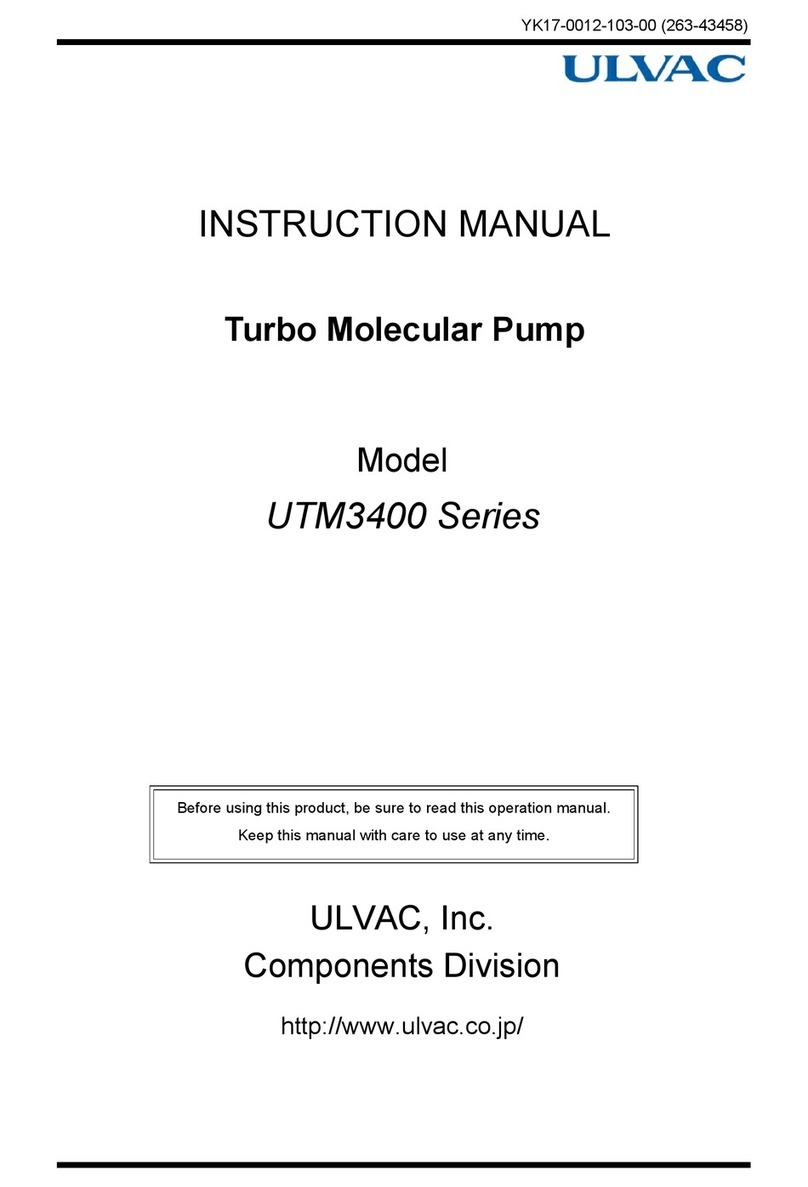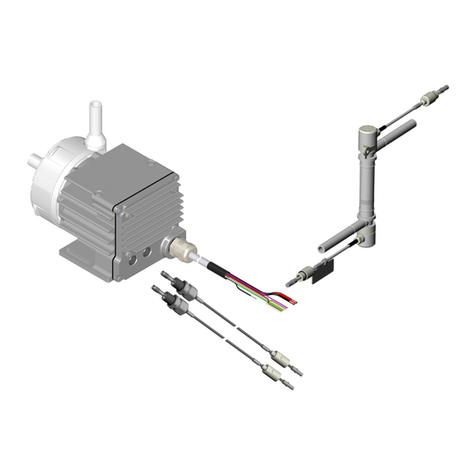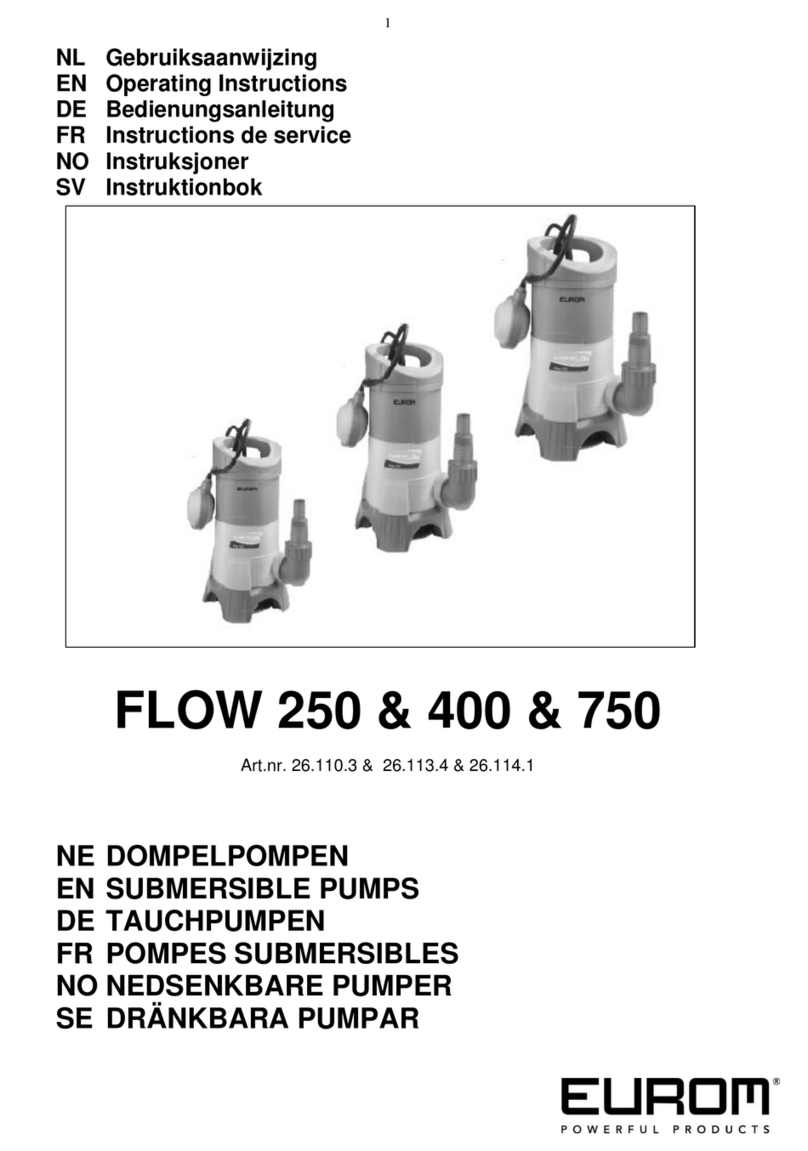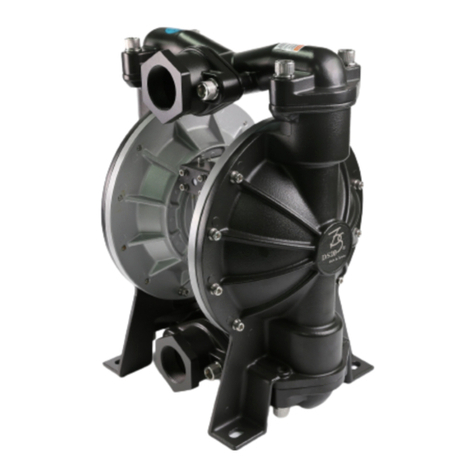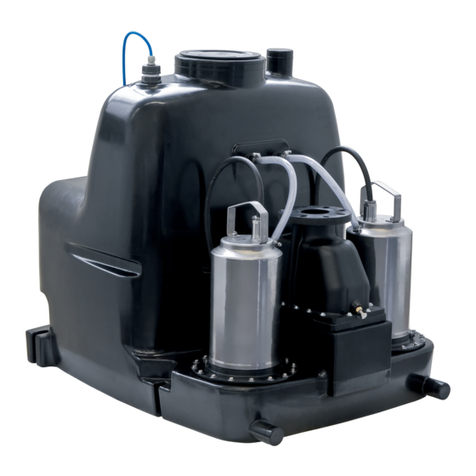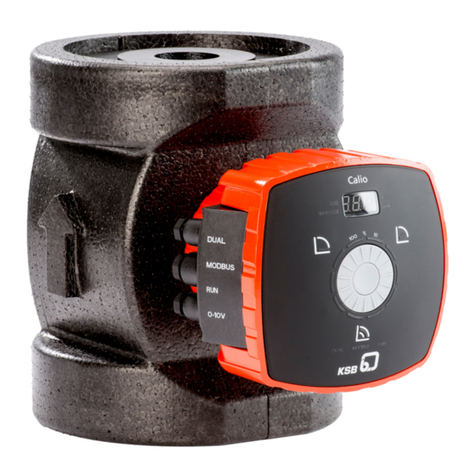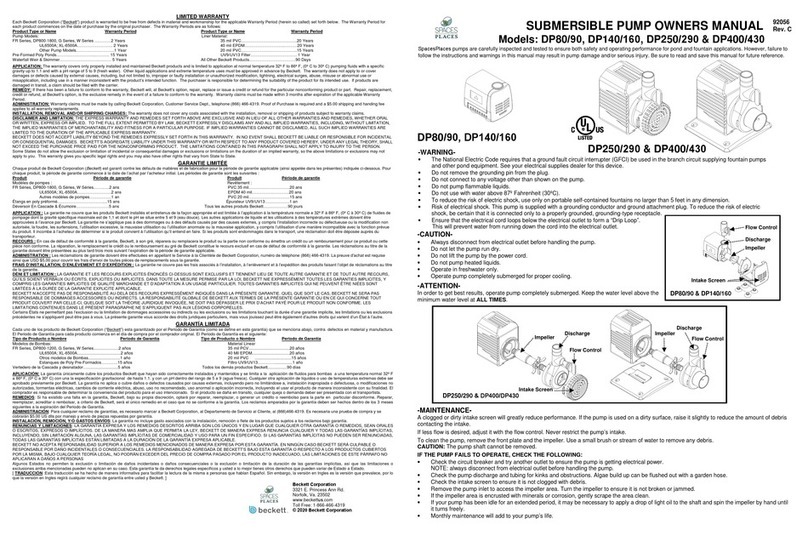Hidrostal A2Q User manual

Instructions
Compact pump A2Q, BN2, BE2, BN3, BK3
13-BA8057 EN
Translation of the original instructions
Before starting work, read these instructions!

Hidrostal AG
Gigering 27
8213 Neunkirch
Switzerland
T +41 (0) 52 687 06 87
F +41 (0) 52 681 20 84
www.hidrostal.ch
Revision status151130
This manual is protected by copyright and is exclusively for internal
purposes.Transfer of this manual to third parties, reproductions in any
manner and form – in full or in part – as well as exploitation and/or
communication of content without written permission from the manufacturer,
except for internal purposes, is prohibited.

Table of contents
Hidrostal AG iii / 49
Table of contents
1 General information .................................................................................................................................5
1.1 Information about these instructions................................................................................................... 5
1.2 Explanation of symbols....................................................................................................................... 5
1.3 Disclaimer ........................................................................................................................................... 6
1.4 Terms of warranty............................................................................................................................... 7
1.5 Customer service and product monitoring .......................................................................................... 7
1.6 Spare parts ......................................................................................................................................... 7
2 Safety requirements ..................................................................................................................................8
2.1 Introduction ......................................................................................................................................... 8
2.2 Responsibility of the operating company ............................................................................................ 8
2.3 Personnel requirements...................................................................................................................... 9
2.4 Intended use ..................................................................................................................................... 10
2.4.1 Application limits ....................................................................................................................10
2.5 Personal protective equipment ......................................................................................................... 10
2.6 Special hazards ................................................................................................................................ 11
2.6.1 Mechanical hazards ...............................................................................................................11
2.6.2 Biohazards ............................................................................................................................. 12
2.6.3 Hazards from electric energy .................................................................................................12
2.6.4 Hazards in the working area ..................................................................................................13
2.7 Safety mechanisms and devices, protection against restart, emergency shutdown, what to do in the
event of danger or accidents ............................................................................................................ 13
3 Technical Data .........................................................................................................................................15
3.1 Intended purpose.............................................................................................................................. 15
3.2 General information .......................................................................................................................... 15
3.3 Operating conditions......................................................................................................................... 15
3.4 Consumables.................................................................................................................................... 16
3.4.1 Overview of hydraulic cooling oil............................................................................................ 16
3.5 Type plate ......................................................................................................................................... 16
4 Design and functions ..............................................................................................................................18
4.1 Overview........................................................................................................................................... 18
4.2 Electric motors .................................................................................................................................. 19
4.3 Operational safety components ........................................................................................................ 19
4.4 Hydraulics ......................................................................................................................................... 21
4.5 Connections...................................................................................................................................... 21
4.6 Controls ............................................................................................................................................ 22
5 Transport and storage ............................................................................................................................23
5.1 Transport .......................................................................................................................................... 23
5.1.1 Symbols and information on packaging .................................................................................23
5.1.2 Packages with anchor points .................................................................................................24
5.1.3 Pallet transport by forklift .......................................................................................................24
5.1.4 Pallet transport by crane ........................................................................................................25

Table of contents
iv / 49 Hidrostal AG
5.1.5 Crane transport of unpacked pump .......................................................................................25
5.2 Storage ............................................................................................................................................. 25
6 Installation and initial commissioning ..................................................................................................27
7 Operation and special operation............................................................................................................28
7.1 Pumping the sump dry...................................................................................................................... 28
8 Maintenance.............................................................................................................................................29
8.1 Maintenance schedule...................................................................................................................... 29
8.2 Service connections and inspection openings.................................................................................. 30
8.3 Tightening torque for greased screw thread ..................................................................................... 31
8.4 Maintenance work............................................................................................................................. 31
8.4.1 Preparation tasks for maintenance ........................................................................................31
8.4.2 Visual inspection ....................................................................................................................31
8.4.3 Check/readjust impeller clearance.........................................................................................32
8.4.4 Checking the oil .....................................................................................................................35
8.4.5 Replacing the pump ...............................................................................................................37
8.5 Measures after completion of work................................................................................................... 40
9 Faults ........................................................................................................................................................41
9.1 Safety................................................................................................................................................ 41
9.2 Fault table ......................................................................................................................................... 42
9.3 Measures after completion of work................................................................................................... 45
10 Disassembly.............................................................................................................................................47
10.1 Safety................................................................................................................................................ 47
10.2 Disassembly ..................................................................................................................................... 47
10.3 Disposal ............................................................................................................................................ 48
11 Appendix ..................................................................................................................................................49

General information | 1
Hidrostal AG 5 / 49
1 General information
1.1 Information about these instructions
Target group The target group of these operating instructions is the pump operating
company once the system, in which the pump is fitted, has been handed
over by the system manufacturer to the operating company in ready-for-use
condition.
The selection of the suitable pump, the safe and correct integration into the
system, the description of the operation, the installation and commissioning
are the system manufacturer's responsibility and are NOT covered in these
operating instructions.
How to use these operating
instructions
These operating instructions contribute to the safe and efficient handling of
the machine. The fundamental prerequisite for safe working is the
adherence to all safety information, warnings and operating instructions
given in the manual.
Reading obligation Before starting any task, personnel must carefully read and understand this
manual.
Storage location These instructions are part of the machine and must be stored in an easily
accessible location for personnel to consult before starting work.
Resale If the machine is sold or transferred, the operating instructions must also be
passed on to the new owner.
Other applicable
documents, regulations
and directives
Besides these operating instructions, the instructions and information as well
as the signs on the machine also apply. Any advice on technical
modifications must be attached to these instructions. Furthermore, the local
accident prevention regulations and general safety regulations for the
application range of the machine apply.
Illustrations in these
instructions
Illustrations in these instructions are provided for general understanding and
may differ from the actual design of the machine.
Loss of the operating
instructions
If these operating instructions are lost, please order replacement
immediately (delivery against a nominal charge). Contact data see Imprint
[▶2].
1.2 Explanation of symbols
Symbols are used to denote safety notes and warning messages in these
instructions. Signal words are found at the start of the safety notes and
warning messages and are used to express the severity of the hazard.
Safety instructions must be observed and proper care must be taken to
avoid accidents or injury and damage to property.
DANGER
... indicates an imminent dangerous situation that will result in death or
serious injuries if not prevented.

1 | General information
6 / 49 Hidrostal AG
WARNING
... indicates a potentially dangerous situation that could result in death or
serious injuries.
CAUTION
... indicates a potentially dangerous situation that could result in minor
injuries.
NOTICE
... indicates a potentially dangerous situation that could result in damage to
property.
NOTE
... indicates helpful advise and recommendations as well as information for
efficient and trouble-free operation.
1.3 Disclaimer
Information in these
instructions
The information and safety warnings in these instructions of use have been
composed with regard to the applicable standards, directives and
regulations, the state of technology and our years of experience.
Due to the optional equipment, production of custom models or technical
changes reflecting technological improvements, the scope of delivery and
the execution of the machine can deviate from the descriptions and
depictions contained herein.
Supply, delivery Beyond the contractually negotiated obligations, the General Terms &
Conditions and delivery terms of the supplier also apply. These are subject
to the applicable laws at the time of signing of the contract.
Technical changes The publication date of these operating instructions applies. Hidrostal AG
reserves the right to make technical changes to the machine as part of
redevelopment to improve its safety and functionality.
Disclaimer The manufacturer excludes liability for damage and accidents related to the
following points:
• Non-intended use of the machine
• Non-compliance with the information and warnings given in these
operating instructions
• Work on, or with the machine, by unqualified or unauthorised personnel
• Installation of non-genuine spare parts
• Unauthorised modifications without the written approval from the
manufacturer
• Use of unauthorised operating materials

General information | 1
Hidrostal AG 7 / 49
1.4 Terms of warranty
Location The terms and conditions can be found in the purchase agreement and the
supplier's General Terms & Conditions.
Fundamentals The supplier will make final decisions on claims following the return or return
shipment of all defective components, or following an on-sight inspection if
necessary. The replacement of defective parts does not extend the warranty
period of the machine. Modifications or significant repairs by the operating
company or third parties undertaken without the written consent of the
supplier void the warranty.
1.5 Customer service and product
monitoring
Customer service Our customer service department is available in the event of problems or if
questions arise that cannot be resolved solely through this user manual, as
well as for technical queries. For contact data, see Imprint [▶2].
Product monitoring In our efforts to constantly improve our product, we in the Customer Service
department are interested in hearing about your experiences in working with
the machine.
Please inform us of any problems or errors that you may have encountered
while handling the machine. Please notify the manufacturer of any accidents
or hazardous incidents.
1.6 Spare parts
Spare parts shall be obtained from an authorised dealer or directly from
manufacturer. Contact data see Imprint [▶2].
When using non-approved spare parts, all claims concerning warranty,
service, damage and/or liability against manufacturer or his agents, dealers
and representatives will be forfeited.
NOTE
When making spare parts enquiries or placing spare parts orders, complete
information must be provided such as Type designation in the contract. The
spare parts list can be found in Appendix [▶49].

2 | Safety requirements
8 / 49 Hidrostal AG
2 Safety requirements
2.1 Introduction
This section provides an overview of all key safety aspects for optimum
safety of personnel, as well as safe and highly reliable operation.
Non-compliance with the operating instructions as well as the safety
information and warnings listed in this manual can result in considerable
risks.
These operating instructions can only include the risks that have been
identified on the basis of a risk assessment. Risks that occur due to working
conditions, the location of the machine and the interfaces with external
components must be determined and the safety instructions amended
accordingly.
2.2 Responsibility of the operating
company
Definition of terms The term “operating company” as used in these instructions refers to the
company or its management that procures the machine (purchase, lease,
rent, etc.) and assigns personnel with the task of handling the machine
(transportation, installation, operation, maintenance, etc.).
Fundamentals Since the machine is intended for use in a commercial environment, the
operating company is strictly subject to the statutory requirements governing
safety at the workplace. In addition to the safety warnings in these operating
instructions, the safety, accident prevention and environmental protection
regulations governing the location where the machine is to be used are also
applicable.
Risk assessment The operating company must inform themselves about the applicable
occupational safety regulations. A risk assessment must also be carried out
to identify additional risks resulting from the specific working conditions at
the location of operation.
Operating Instructions According to the results of the risk assessment of the workplace, the
operating company must initiate, implement and document the operating
instructions. The operating company is responsible for ensuring that these
operating instructions are kept up to date with the current legal requirements
for the entire service life of the machine.
Responsibilities The operating company must manage the responsibilities for work on or with
the machine, including naming a party to be responsible for the safe
operation of the machine and coordinating all tasks.
Information flow The operating company must ensure that all personnel who carry out work
on or with the machine have read and understood these and other
supplementary operating instructions.
Personal protective
equipment
The operating company must provide operating personnel with the
necessary personal protective equipment.

Safety requirements | 2
Hidrostal AG 9 / 49
Safety requirements Where applicable, before commissioning, the operating company must make
sure that the machine into which this product is to be installed, or of which it
represents a component, corresponds to the fundamental safety
requirements and stipulations of all relevant directives.
Technically flawless
condition
To keep the machine in a technically flawless condition at all times, the
operating company must ensure that the maintenance intervals prescribed in
these operating instructions are complied with. The operating company must
furthermore ensure that all necessary safety mechanisms and devices are
properly installed on the machine. The safety mechanisms and devices must
be inspected regularly to check that they are all present and functioning
properly.
2.3 Personnel requirements
General information As personnel, the only authorised persons are those who carry out their task
reliably and whose responses are not impaired, e.g. by drugs, alcohol or
medication.
When selecting personnel, observe the applicable job-specific age
regulations applicable at the location of operation of the machine.
WARNING
Incorrect operation because of insufficient qualifications and knowledge.
Unauthorised persons who do not satisfy the conditions stated here are
unable to recognise the risks in the areas of operation.
Risk of severe injury!
• All tasks may only be carried out by suitably qualified personnel.
• Keep unauthorised personnel away from the danger areas.
In the operating instructions, the qualifications for the various tasks are
specified as follows:
Trained personnel Trained personnel have the technical education, know-how and experience
as well as the knowledge of applicable standards and regulations that allow
them to execute the work assigned to them and to independently recognise
and avoid potential dangers.
Trained personnel are also trained by Hidrostal or a Hidrostal sales partner
in how to operate the pump. The completion of training programs must be
documented.
Manufacturer (service
centre)
Only trained Hidrostal personnel or trained personnel of a Hidrostal sales
partner are allowed to carry out service work. Nobody else is allowed to
perform this work. To have the required work performed, please contact our
Service department, see Imprint [▶2].
Qualified electricians Qualified electricians possess the technical education, knowledge and
experience as well as knowledge of applicable standards and regulations
that allow them to execute work on electrical equipment and to
independently recognise and avoid potential dangers.
Qualified electricians are trained for the specific site where they work and
know the relevant directives, standards and specifications.

2 | Safety requirements
10 / 49 Hidrostal AG
Forklift drivers Forklift drivers must be at least 18years old and their physical, mental state
and personal characteristics must be such that they are capable of driving a
forklift either in seated or standing position.
Furthermore, forklift drivers must have received training in how to operate a
forklift in seated or standing position.
Forklift drivers must have demonstrated to the operating company their
ability to operate a forklift in a seated or standing position and have been
instructed in writing by the operator to do so.
Hoisting equipment
operators
Hoisting equipment operators have been trained and authorised to perform
this work.
Instructed persons
(operators)
Instructed persons have been informed by trained personnel about the
assigned tasks and possible hazards in case of incorrect behaviour. The
completion of training programs should be documented.
2.4 Intended use
The pump is exclusively intended for pumping liquids and viscous, non-
combustible media.
If extremely abrasive or aggressive media are circulated, the pump must be
designed in resistant material.
Pumps of the types A2QR2, A2QR4, A2QS2, A2QS4, A2QE4, BE2, and
BK3 can be operated when they are immersed or when they are
permanently outside the liquid. The types A2QE2, BN2, and BN3 must
always be immersed during operation (exception see chapter Pumping the
sump dry [▶28]).
The pump must be kept in a clean and sound condition and its construction
may not be altered from its delivered state.
Intended use also includes compliance with all information contained in
these operating instructions.
Any use beyond the one intended, or other use of the machine is regarded
as misuse and can result in dangerous situations.
2.4.1 Application limits
No potentially explosive atmosphere
WARNING
Potentially explosive atmospheres.
Risk of fatal injury!
• Potentially explosive atmospheres in the pump interior or the ambient
environment are NOT permissible.
2.5 Personal protective equipment
Some tasks require personal protective equipment to be worn.

Safety requirements | 2
Hidrostal AG 11 / 49
In addition to the personal protective equipment specified in these operating
instructions, also observe the warnings located in the work area.
2.6 Special hazards
The following section indicates residual risks determined by a risk
assessment.
• The safety instructions listed here and the warnings in the following
chapters of these instructions must be observed in order to reduce health
hazards and avoid dangerous situations.
2.6.1 Mechanical hazards
WARNING
Suspended loads.
Suspension points weakened by corrosion and/or mechanical stress.
Risk of fatal injury!
• Use suitable, undamaged hoisting equipment only.
• If there is a suspicion of weakened suspension points, secure the load
with suitable sling gear.
• Only move loads under supervision.
• Never stand below suspended loads.
• Before leaving the work area: bring the load to the ground.
WARNING
Tipping loads.
Risk of severe injury!
• Always sufficiently secure components against tipping.
• Use suitable, undamaged hoisting equipment only.
• Only move loads under supervision.
CAUTION
Sharp edges on the edge and inside the pump chamber.
Risk of injury!
• Proceed carefully when working in the vicinity of sharp edges.
• Wear safety gloves.

2 | Safety requirements
12 / 49 Hidrostal AG
WARNING
Flying parts when cleaning with a high-pressure cleaner.
Risk of severe injury!
• Wear safety goggles.
CAUTION
Wood splinters and nails on packaging material.
Risk of injury!
• Wear safety gloves.
2.6.2 Biohazards
WARNING
Contact with infectious substances.
Risk of severe illness!
• Obtain binding information about the hazards relating to the medium from
the operator of the plant.
• Wear personal protective equipment.
• Thoroughly clean the pump.
• Carefully dispose of liquid drained from the oil chamber.
• Thoroughly clean tools after use.
2.6.3 Hazards from electric energy
DANGER
Contact with live parts.
Damaged cable insulation
Risk of fatal injury!
• In case of damaged insulation, disconnect the power supply immediately
and have it repaired.
• Before connecting the machine to the power supply, compare the
specifications Type plate [▶16] with those of the grid and only connect
if they are identical.
• Any work on the electrical system must be performed by authorised
electricians.

Safety requirements | 2
Hidrostal AG 13 / 49
2.6.4 Hazards in the working area
WARNING
Dirt and items left lying around represent tripping hazards.
Risk of severe injury!
• Always keep the work area clean.
• Remove objects that are no longer required.
• Use black/yellow tape to mark areas where there is a risk of tripping.
For pumps that are operated outside the liquid (A2QR2, A2QR4, A2QS2,
A2QS4, A2QE4, BE2, BK3):
WARNING
Work at the pump location, noise from neighbouring pumps, tank
overflowing.
Risk of injury!
Risk of permanent health damage!
• Always wear hearing protection near running pumps.
• Before entering a tank, make sure at the control console that the tank will
not be flooded during the work.
CAUTION
Insufficient lighting in the work area.
Risk of injury!
• Provide adequate lighting at the workplace.
• Immediately replace defective lighting components.
2.7 Safety mechanisms and devices,
protection against restart, emergency
shutdown, what to do in the event of
danger or accidents
The system manufacturer is responsible for ensuring the safety of the
system in which the pump is installed. This aspect is not covered in these
operating instructions.
The system must be fitted with at least a lockable mains switch, to ensure
that all the conductors connected to the pump is voltage free and to prevent
an unintentional restart.

Technical Data | 3
Hidrostal AG 15 / 49
3 Technical Data
3.1 Intended purpose
No potentially explosive atmosphere
WARNING
Potentially explosive atmospheres.
Risk of fatal injury!
• Potentially explosive atmospheres in the pump interior or the ambient
environment are NOT permissible.
Permissible media The pump is exclusively intended for pumping liquids and viscous, non-
combustible media.
If extremely abrasive or aggressive media are circulated, the pump must be
designed in resistant material.
Pumps of the types A2QR2, A2QR4, A2QS2, A2QS4, A2QE4, BE2, and
BK3 can be operated when they are immersed or when they are
permanently outside the liquid. The types A2QE2, BN2, and BN3 must
always be immersed during operation (exception see chapter Pumping the
sump dry [▶28]).
3.2 General information
NOTE
For contract-related technical data (dimensions, weights, performance,
connected loads, etc.) refer to enclosed delivery drawings and data sheets,
see chapter Appendix [▶49].
3.3 Operating conditions
Temperature NOTICE
Frozen medium inside the pump.
Risk of failure of the pump housing!
• Make sure that the medium inside the pump and the connected hose
lines does not freeze.
• It is particularly important to make sure that the volume behind the
impeller is drained on pumps that are subject to frost (e.g. by blowing out
with compressed air).
Declaration Value
Temperature of medium max. 40°C

3 | Technical Data
16 / 49 Hidrostal AG
Declaration Value
Ambient temperature max. 40°C
Duration The pump is designed for continuous operation (S1 pursuant to EN
60034-1:10/2010).
Installation position The pump can be operated horizontally or vertically.
3.4 Consumables
3.4.1 Overview of hydraulic cooling oil
Name Manufacturer Density at 15°C
[kg/m³]
Viscosity at
40°C [mm²/s]
Flash point
COC [°C]
used by
manufacturer:
Rinatol 856 Ess+Müller CH-8200
Schaffhausen
850 14.2 190
alternative oils
recommended
by
manufacturer:
Tellus S2 V 15 Shell Oil 872 15 170
Hyspin HVI 15 Castrol 874 15 160
Equivis ZS 15 Total 853 15 174
NOTE
Other equivalent mineral oils can also be used. The viscosity at 40°C may
not exceed 15mm²/s and the flash point must never be below 155°C.
3.5 Type plate
The type plate is located on the motor housing.
1
2
3
4 5 6 7
8910
11 12 13
14 15 16
17 18
19 20
Item Declaration Example
1 Manufacturer Hidrostal AG
8213 Neukirch
Switzerland
2 Type C0CQ-RL3 + CNBA2-GSEQ1
+ NW1A2O-10

Technical Data | 3
Hidrostal AG 17 / 49
Item Declaration Example
3 Order number 12007807
4 Serial number 212832
5 VDE 0530 (rotating electrical
machines)
07/91
6 Insulation class F
7 Protection classes 68
8 Mains frequency 50Hz
9 Mains voltage 400V
10 Nominal motor current 7.8A
11 Power input kW* (customer data)
12 Power factor 0.88
13 Nominal speed 27901/min
14 Nominal output 3kW
15 Phase sequence Y
16 Weight 66.2 kg
17 Flow rate l/s* (customer data)
18 Delivery height m* (customer data)
19 CE marking see Declaration of Conformity
in the appendix
20 Ambient temperature 40°C
* Fields can remain empty.

4 | Design and functions
18 / 49 Hidrostal AG
4 Design and functions
4.1 Overview
1
2
3
4
5
6
1 Cable cover
2 Electric motor
3 Oil chamber
4 Hydraulic part
5 Suction flange
6 Pressure flange
The impeller of the hydraulic part (3) sucks in the conveyed medium via the
suction flange (4) and conveys it to the pressure flange (5).

Design and functions | 4
Hidrostal AG 19 / 49
4.2 Electric motors
3
1
2
1 Stator housing
2 Opening to drain, fill in, and test the oil
3 Flushing port to remove obstructions from behind the impeller
The pump is equipped with a submersible motor that is installed in the pump
sump.
Pumps of the types A2QR2, A2QR4, A2QS2, A2QS4, A2QE4, BE2, and
BK3 can be operated when they are immersed or when they are
permanently outside the liquid. The types A2QE2, BN2, and BN3 must
always be immersed during operation (exception see chapter Pumping the
sump dry [▶28]).
4.3 Operational safety components
NOTICE
Incorrect design of system control.
Bypassing of safety components.
Risk of damage to property!
• ALL of the safety components below will only function correctly if the
system control analyses them correctly.
The following components can be installed:

4 | Design and functions
20 / 49 Hidrostal AG
1
2
3
1 Coil head with integrated temperature limiter (bimetal switch or PTC
probe, option)
2 Moisture sensor (BN3, BK3 only; option)
3 Temperature limiter installed in the cable cover (bimetal 80°C, not
available for A2Q)
NOTICE
Improper electrical connection.
Risk of damage to property!
• Never connect a PTC probe to more than 2.5V.
Temperature monitoring:
Bimetal switch or PTC
probe:
Temperature monitoring sensors protect the electric motor winding against
excessive temperatures. Bimetal switches (NC) and thermistors (PTC) are
used. In contrast to bimetal switches, thermistors are still able to protect the
electric motor when the rotor is blocked and start-up is sluggish.
Three 150°C bimetal switches are installed in the top coil head and
connected in series. The top coil head also holds three 150°C thermistors
connected in series. Each phase has one sensor of each kind. Depending
on the configuration, the connection cables of the sensors are provided via
the control cables.
The temperature monitoring sensors, such as the bimetal switches or
thermistors, always need to be evaluated by the electronic evaluation
system. Bimetal switches can be connected to a certified electronic
evaluation system or directly to the control unit (max. 250VAC, 2.5A).
Thermistors must only be operated and evaluated with a certified electronic
evaluation system. Thermistors always need to be employed for temperature
monitoring during frequency converter operation. In this case, they can be
directly connected to the frequency converter.
This manual suits for next models
4
Table of contents
Popular Water Pump manuals by other brands
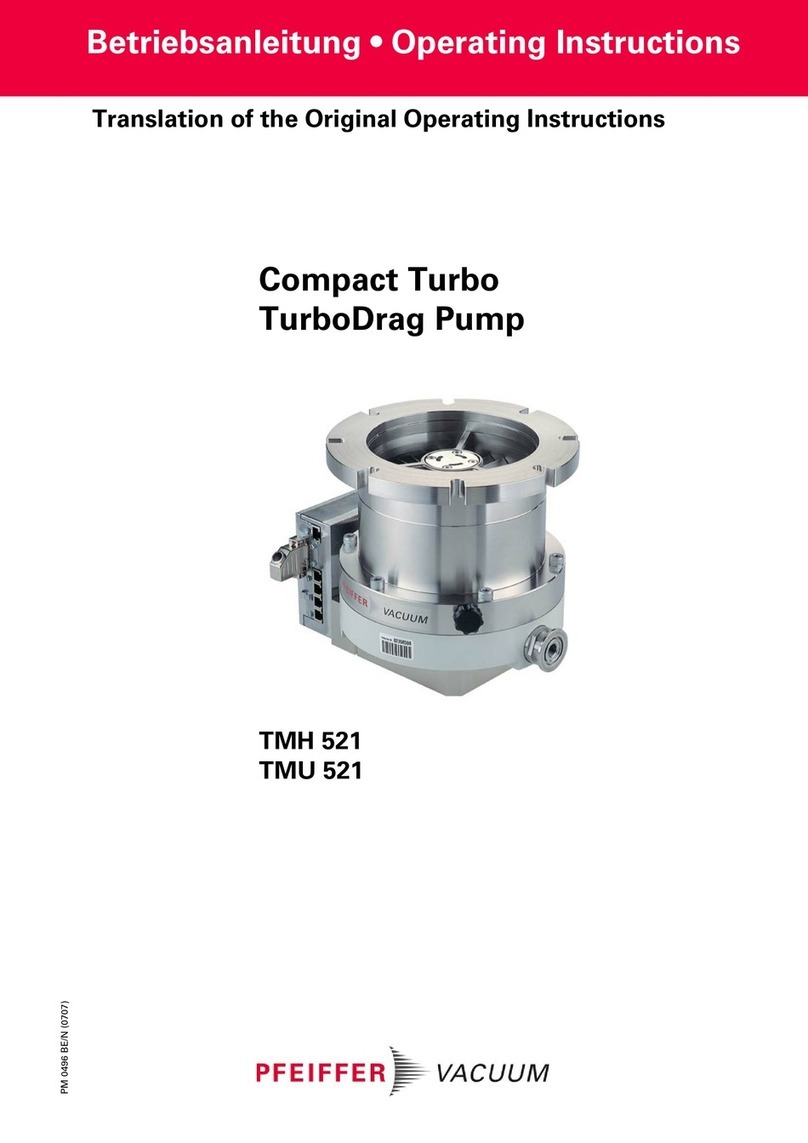
Pfeiffer Vacuum
Pfeiffer Vacuum TMH 521 Translation of the original operating instructions
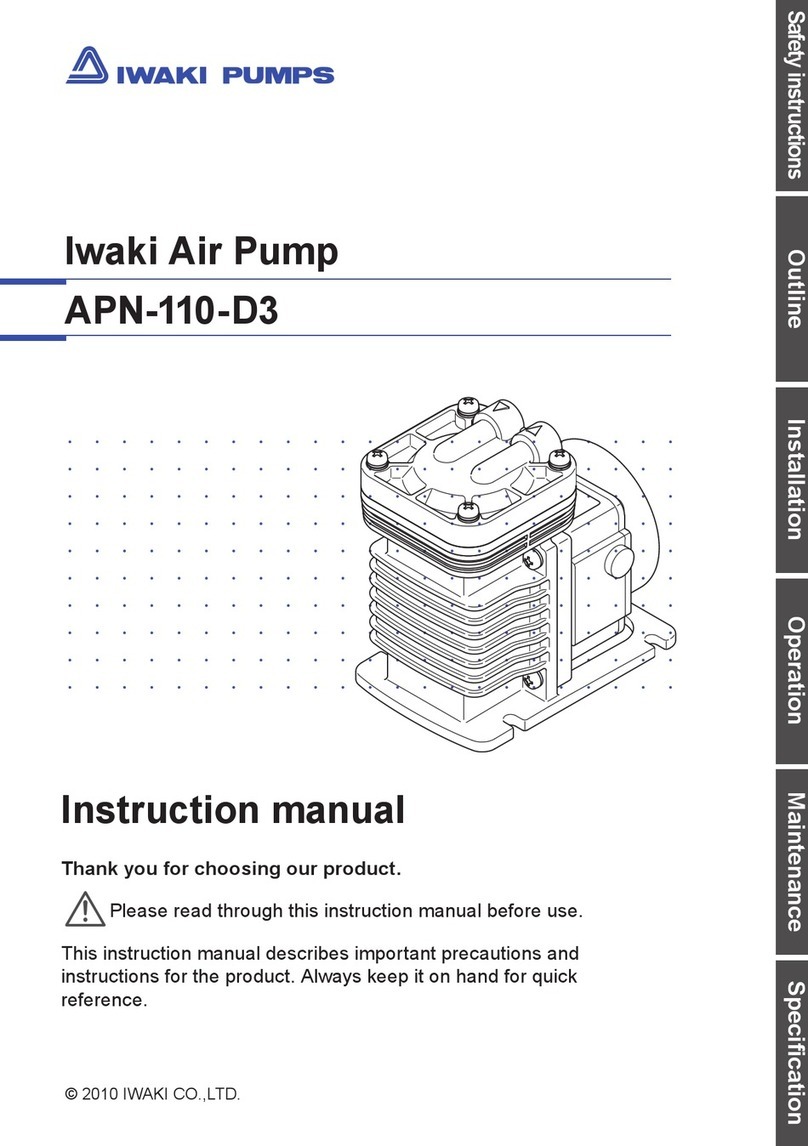
IWAKI PUMPS
IWAKI PUMPS APN-110-D3 instruction manual
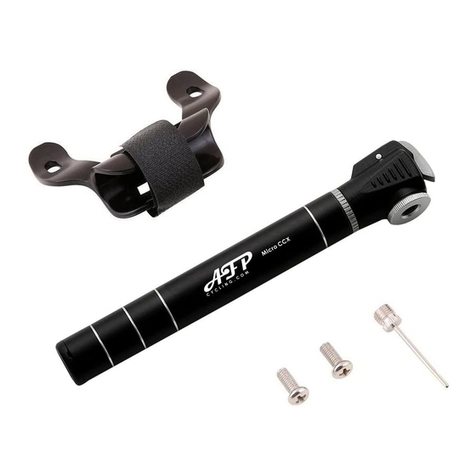
AFPCYCLING
AFPCYCLING Micro CCX instruction manual

Chicago Electric
Chicago Electric 95591-.75 HP operating instructions

Larzep
Larzep W Series Operation manual

BUSCH
BUSCH COBRA NX 0450 A instruction manual


